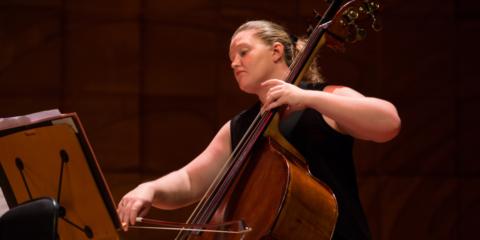MCO’s Songs of the Night can be heard in Melbourne on Sunday 18 June at Melbourne Recital Centre & Thursday 22 June at The Deakin Edge, Federation Square.
MCO: This concert takes us into the fascinating world of arrangements, with a number of beautiful rare works too. Can you tell us what the music in this concert is like and what people can expect?
Emma:This program is an exploration of the richness and expression of the late Romantic era. It features art songs by Strauss, Schoenberg and Schubert, with the piano parts arranged for string orchestra. Although each featured song is inspired by night, they are a study in contrasts, from the reflective meditation of Schubert’s Nacht und Träume to the drama and despair of the iconic Der Erlkönig, which depicts a desperate father trying to save his son’s life. Setting these songs for voice with strings will intensify the expression and emotion of the music. The centrepiece of the program is Schoenberg’s Verklärte Nacht. Most people are familiar with Schoenberg as a revolutionary modern composer who developed the twelve-tone composition technique. However, his early works are deeply entrenched in Romantic tradition and language. Verklärte Nacht is expressive, lush and full of rich harmonies, similar to Wagner’s Prelude to Tristan und Isolde, which opens the program. Schoenberg’s song Waldesnacht predates Verklärte Nacht by a few years – here the influence of Brahms is pervasive. The effervescent Scherzo from Mendelssohn’s A Midsummer Night’s Dream and pizzicato fourth movement from Bartok’s 4th String Quartet offer some lighter and more playful moments within the program.
MCO: There’s a new work by Lachlan Skipworth on the program. How do you personally, and in your experience how does an orchestra, approach a new work?
Emma: This tour is the world premiere season for The Expanse by Lachlan Skipworth. Learning a completely new work is always an interesting experience. When we approach the works of composers like Schubert and Schoenberg, we come to the music with an established body of knowledge from previous study and performances. A newly composed work is a clean slate, where you have the opportunity to create something new, alongside the composer. Often, we are able to rehearse new commissions with the composer present or communicate with them throughout the rehearsal process, which allows us insight into their vision for the work. Contemporary composers are often quite explicit in their directions on the score, including metronome markings and written instructions. Approaching a work for the first time, this information is a good starting point, as well as becoming accustomed to the composer’s style by listening to some of their other works. Within the ensemble setting, the process isn’t particularly different to how we approach the rest of the program – we firstly play through the work together and make sense of the score and then we work together to bring the intentions of the composer to life.
MCO: The orchestra works with many soloists – we haven’t worked with a male vocalist in around a decade. Is it different to work with vocal soloists than with instrumental soloists?
Emma: One of the greatest aspirations we have as string players is to sing through our instruments, so it is always really inspiring to work with vocalists, particularly one of Andrew Goodwin’s calibre. In many ways, working with a vocal soloist poses the same challenges as an instrumentalist in achieving good ensemble, blend and balance. However, one notable difference is that vocal music brings a text to life. To fully do justice to the works featured in Songs of the Night, it is important for us to not only prepare the music from a technical standpoint, but to also understand its intended narrative. The art songs we will be presenting all employ word painting, where the musical language is used to depict specific words, concepts and images. Understanding these details in the music will allow for a more evocative and expressive performance.

